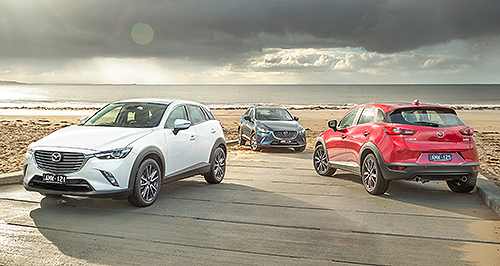News - Mazda - CX-3 - rangeMazda drops diesel power from CX-3 rangeExit stage left: Diesel has found fame in Mazda’s bigger SUV offerings but not in the baby CX-3. Mazda “rationalises” CX-3 line-up and drops slow selling diesel powertrain10 Mar 2020 MAZDA Australia has quietly given the diesel variants of its CX-3 compact SUV the backdoor shuffle, reducing the number of available powertrain options from two to just one.
That now singular engine choice is the familiar atmospheric 2.0-litre four-cylinder petrol unit, which in CX-3 guise, produces 110kW of power and 195Nm of torque – 25kW more than the dropped 1.8-litre turbo-diesel but a hefty 75Nm less torque.
According to Mazda Australia public relations and corporate communications senior manager Mark Flintoft, the decision to drop the diesel was made due to the overwhelming sales preference of the petrol engine.
“CX-3 production moved from Thailand to Japan at the start of the year and presented a chance to rationalise the range, part of which included dropping diesel,” he said.
“CX-3 customers much prefer petrol with regards to sales volume.”
The sole transmission choice for the diesel was a six-speed automatic unit – shared with the petrol versions – with drive going to either the front wheels in the Maxx Sport or all four wheels in the higher grade sTouring and Akari.
Shedding the diesel powertrain has reduced the expansive CX-3 line-up from 16 to a still plentiful 13, nine of which are front-wheel drive.
The same two transmission choices remain for the petrol cars, a six-speed manual and the aforementioned six-speed automatic, with no other changes made across the range other than the diesel’s subtle exit.
While the diesel option is now gone from the smallest of Mazda’s SUVs, Mr Flintoft assured GoAuto that the oil-burning powertrain option still had a firm place in the Japanese brand’s line-up, especially at the larger end of the scale.
“In 2007, Mazda announced its commitment to Sustainable Zoom-Zoom – Mazda’s vision for a low emissions future that would reduce vehicle fleet emissions by 50 per cent from 2010 to 2030 and 90 per cent to 2050,” he said.
“Mazda’s solution here is to achieve this by a multi-solution approach… Mazda sees diesel engines as part of its multi-solution approach.”
Another aspect of this multi-solution approach will be the launch of the all-electric and similarly sized MX-30 SUV, the brand’s first dedicated electric vehicle.
Mazda Australia executives promised earlier this year that a decision whether the MX-30 would make it to Australian shores would be made by mid-year.
As for the rest of Mazda’s local range, diesel engines can still be had in the mid-sized CX-5, seven-seat CX-8 and BT-50 pick up.
Last year Mazda sold 14,813 CX-3s, accounting for 12.1 per cent of the crowded sub-$40,000 compact SUV segment, second only to the Mitsubishi ASX with 20,806 sales (16.9 per cent market share).
So far this year it has managed 2660 sales, accounting for 60.3 per cent of the light SUV segment – a year-on-year increase of 6.6 per cent.  Quick tests28th of August 2018 Mazda CX-3The Mazda CX-3 facelift fixes several of its predecessor’s faultsRead more |
Click to shareMazda articlesResearch Mazda CX-3 pricing
Motor industry news |

















Facebook Twitter Instagram